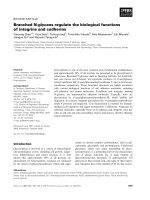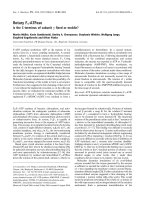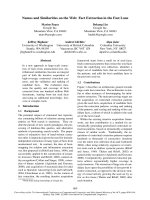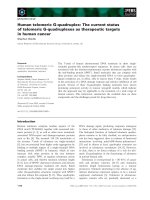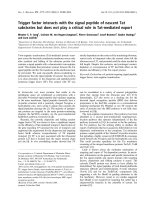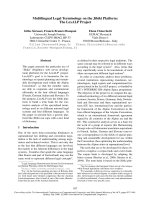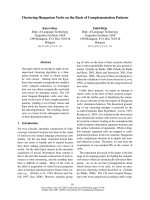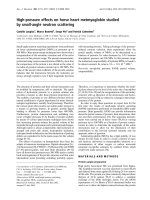Báo cáo khoa học: "Flow cytometric evaluation on the age-dependent changes of testicular DNA contents in rats" pdf
Bạn đang xem bản rút gọn của tài liệu. Xem và tải ngay bản đầy đủ của tài liệu tại đây (3.37 MB, 4 trang )
9HWHULQDU\
6FLHQFH
J. Vet. Sci. (2001), 2(1), 43–46
Flow cytometric evaluation on the age-dependent changes of testicular
DNA contents in rats
Chang Yong Yoon*, Choong Man Hong, Yong-Yeon Cho, Ji Young Song, I Jin Hong, Dae Hyun Cho,
Beom Jun Lee
1
, Hee Jong Song
2
and Cheol Kyu Kim
Department of Pathology, National Institute of Toxicological Research, Korea Food and Drug Administration, Seoul 122-704, Korea
1
Safety Research Center, Korea Testing and Research Institute for Chemical Industry, Seoul 150-038, Korea
2
Department of Infectious Diseases, College of Veterinary Medicine, Chonbuk National University, Chonju 561-756, Korea
An age-dependent cellular change of DNA contents in
the testis of Sprague-Dawley rats was investigated by
flow-cytometric method. Testicular cell suspensions at the
age of 4, 5, 6, 7, 8, 10, 12, 16 and 26 weeks were prepared
and stained with propidium iodide. The relative propor-
tions in the number of mature and immature haploid (1n),
diploid (2n), S-phase and tetraploid (4n) cells were calcu-
lated. The proportion in the number of mature haploid
cells was sharply increased to the age of 10 weeks (about
38%), thereafter increased slightly to the level of 42% at
the age of 26 weeks. The proportion of immature haploid
cells was dramatically increased to the age of 6 weeks,
then maintained at the level of 20 to 30% thereafter. The
proportion of diploid cells was 64% at the age of 4 weeks,
then decreased gradually through the age of 26 weeks.
The proportion of S-phase cells was increased to the age of
4 weeks, then maintained at a plateau level to the age of 26
weeks. The proportion of tetraploid cells were about 26%
at the age of 4 weeks, then decreased gradually to the age
of 26 weeks. These results suggest that the proportions of
testicular cells may depend on the age of the rat and that
the flow cytometric method may be useful in the evalua-
tion of the spermatogenic status with regard to accuracy
and sensitivity.
Key words:
flow cytometry, SD rats, testis, DNA contents
Introduction
Assessment of a chemical or physical agent on repro-
ductive functions is of paramount important when it may
interfere with the ability of individuals to produce normal
progeny [12]. Several methods have been used for the eval-
uation of a chemical on testicular damage. They include
mating and pregnancy outcome, sperm production and
motility, and histopathology, etc [11]. These methods are,
however, subjective and time-consuming [11]. Recently,
flow cytometry (FCM) method has been used as a useful
investigative tool in a wide range of disciplines including
spermatogenic analysis [10]. As compared with current
methods for the evaluation of spermatogenic impairment,
FCM offers advantages in terms of objectivity, rapidity,
analysis of large number of cells providing high statistical
significance, and unbiased cell sampling [4]. It also pro-
vides quantitative values for evaluating different cell types
on the basis of their DNA ploidy/stainability level [8].
Some mutagenic and/or cytotoxic chemicals have been
known to exhibit stage-specific effects on germ cells or on
reproductive maturation. The effects of these chemicals on
developmental changes in the growing mammalian testis
can be evaluated by FCM. Using FCM technique, we
report the relative proportion of propidium iodide (PI)-
stained testicular cells of Sprague-Dawley (SD) rats aged
from 4 to 26 weeks old.
The results obtained in this study may support the use-
fulness of FCM with regard to accuracy and sensitivity in
the evaluation of the spermatogenic status in normal and
disturbed situation in rats.
Materials and Methods
Experimental Animals
Male SD rats aged from 4 to 26 weeks old were
obtained from the laboratory animal resources of Korea
Food and Drug Administration (KFDA). The animals were
kept in plastic cages and fed with pelleted food and tap
water
ad libitum
. Animal facilities were maintained at the
temperature of 21
±
2
o
C, the relative humidity of 60%, and a
12-h light/dark cycle. The animals were divided into nine
experimental groups dependent on the age of rats (4, 5, 6,
7, 8, 10, 12, 16 and 26 weeks old). Each group contained 5
male rats.
*Corresponding author
Phone: +82-2-380-1817; Fax: +82-2-380-1820
E-mail:
44 Chang Yong Yoon et al.
Sample Preparation
Five animals were killed by cervical dislocation at the
age of 4, 5, 6, 7, 8, 10, 12, 16, and 26 weeks. Both right
and left testes were surgically excised and testicular cell
solutions were prepared for determining the relative pro-
portions of haploid, diploid, S-phase and tetraploid cells
using FCM technique. The preparation of testicular sample
was performed by the following three steps. The stock
solution containing 0.5 mM Tris, 3.4 mM trisodiumcitrate,
0.1% nonidet P-40 (NP-40), and 1.5 mM spermine tetrahy-
drochloride was prepared. First, clean nuclei were obtained
by treatment of solution A (pH 7.6) containing 1,000 ml of
the stock solution and 30 mg of trypsin. The trypsinization
by solution A increased the fluorescence of nuclei with
dense chromatin, presumably by splitting some chromo-
somal proteins. Second, RNase treatment with solution B
(pH 7.6), containing 1,000 ml of stock solution, 500 mg of
trypsin inhibitor, and 100 mg of RNase A, prevented dye
binding to double-stranded RNA. Third, the use of solution
C (pH 7.6), containing 1,000 ml of stock solution, 416 mg
of propidium iodide, and 1160 mg of spermine tertahydro-
chloride, increased optimal stability. In brief, after removal
of fat and connective tissue, testes were stored in citrate
buffer (250 mM Sucrose, 40 mM Trisodium citrate · H
2
O,
5% DMSO, pH 7.6) at -80
o
C in polypropylene tubes
(52
×
17 mm tubes with screw cap, Wheaton, Millville,
N.J. USA) until use. Each sample was thawed, decapsu-
lated and minced with surgical scissors, and treated for 30
min at room temperature with citrate buffer under a gentle
magnetic stirring. Staining was done by a stepwise addi-
tion of the staining solutions. Solution A (1800
µ
l) was
added to 200
µ
l of cell suspension (2 × 10
6
cells) in citrate
buffer filtered through a polypropylene filter with 149-
µ
m
pore size (Spectrum Laboratories, Inc.) in order to discard
tissue debris and the solutions were mixed gently. After
standing for 10 min at room temperature and inverting the
test tubes 2-3 times, 1500
µ
l of solution B was added to the
cell solutions and again mixed gently. Then after standing
for 10 min at room temperature, 1000
µ
l of ice-cold solu-
tion C was added to the cell solutions. The cell solutions
were mixed and filtered through a 60-
µ
m nylon filter
(Spectrum Laboratories, Inc.) into tubes wrapped in alumi-
num foil for light protection of the propidium iodide. After
addition of solution C, the samples were kept in an ice bath
for 30 min to 3 hours until analysis.
Flow cytometry
The DNA contents of the dispersed testicular cells were
measured by FCM (Coulter Epics XL, Coulter Corp.,
USA) which was equipped with a 2-W argon laser and
operated on 488 nm. Propidium iodide fluorescent emis-
sions were monitored using a 620 nm band-pass filter,
along with a dichroic long-pass filter, 645 DL. The degree
of fluorescence was directly proportional to the amount of
Fig. 1. Representative histograms drived from PI-stained testicular cells sampled at 4, 5, 6, 7, 8, 10, 12, 16 and 26 weeks age. A, B, C, D
and E peaks represent mature haploid, immature haploid, diploid, S-phase and tetraploid cells, respectively.
Age-dependant change of testicular cells in rats 45
stain absorbed and so directly related to the DNA content
of each cell. A total of 2
×
10
4
events was accumulated for
each histogram. The histograms were analysed with the
curve-integration routines provided by the Coulter Multi-
parameter Data Aquisition and Display Software. The rela-
tive proportions of haploid, diploid, and tetraploid cells
were calculated from the area under peak in the DNA his-
togram.
Results
Testicular cells obtained from rats aging 4, 5, 6, 7, 8, 10,
12, 16 and 26 weeks old were placed in suspension,
stained with PI, and measured by flow cytometry. Fig. 1
displays representative frequencies showing changes in the
proportion in the number of 1n (mature and immature hap-
loid), 2n (diploid), and 4n (tetraploid) cells in the testis of
rat. Testes of 4 weeks old rats exhibited two major peaks
[2n cells (64%) and 4n cells (26%)] and one minor peak
[1n cells (6%)]. In 5 weeks old rats, three definite popula-
tions (1n, 2n, and 4n) were observed. In 6 weeks old rats,
testicular samples exhibited two distinct peaks within the
1n cell population consisting of round/elongating sperma-
tids and elongated spermatids. In rats older than 6 weeks,
the proportion of elongated spermatids increased steadily.
The ratios of the four testicular populations at each time
point were shown in Fig. 2. The initial appearance of 1n
cells (immature haploid) in 4 weeks old rats was coinci-
dent with the maximal number of the 4n cells. The propor-
tion in the number of mature haploid cells was sharply
increased to the age of 10 weeks (about 38%), thereafter
increased slightly to the level of 42% at the age of 26 week
except for 12 weeks old rats. The proportion of immature
haploid cells was dramatically increased to 33% at the age
of 6 weeks, then maintained at the level between 20 and
30% thereafter. The proportion of diploid cells was 64% at
the age of 4 weeks, then decreased gradually through the
age of 26 weeks. The proportion of S-phase cells was also
high at the age of 4 weeks, then maintained at a plateau
level to the age of 26 weeks. The appearance rates of 4n
cells showed a similar pattern to those of 2n cells. The pro-
portion of tetraploid cells were about 26% at the age of 4
weeks, then decreased gradually to the age of 26 weeks.
Discussion
Several variables including seminiferous tubule diame-
ter, testicular biopsy score, and tubular fertility have been
used to assess the status of the testis. Recently, flow cytom-
etry has been reported to be the most sensitive method
[11]. In this study, we identified the various cell types
occurring in the testes of SD rats aged from 4 weeks to 26
weeks old using FCM. Especially, the preparation of sam-
ples was performed by a integrated set of methods [3].
FCM analysis was performed on unfixed material to avoid
a potentially selective cell loss caused by centrifugation
step. Clumping and staining artifacts caused by fixatives
were avoided. In addition, samples could be long-term
stored by freezing(-70
o
C) in a citrate buffer with dimethyl
sulfoxide (DMSO).
In this study, the three major phases including haploid
cells (1n, round, elongating and elongated spermatids,
Fig. 2. Age-dependent percentages of mature haploid(M Hap), immature haploid(IM Hap), diploid(Dip), S-phase(S-p) and
tetraploid(Tetrap) cells present in testis from prepubertal to adult male SD rats.
46 Chang Yong Yoon et al.
spermatozoa), diploid cells (2n, spermatogonial cells, sec-
ondary spermatocyte, Sertoli cells, Leydig cells) and tetra-
ploid cells (4n, mostly primary spermatocyte) could be
distinguished clearly by comparing fluorescent properties
of propidium iodide-stained testicular cell populations [7].
Of these three phases, the haploid (1n) region was splitted
into two peaks because of different stainability of elon-
gated and round/elongating spermatids. This may reflect
progressive condensation of chromatin structure. The
nuclear packaging is known to reduce the number of DNA
sites available for fluorochrome binding, thus resulting in
an apparently sub-haploid DNA content [9]. The appear-
ance of round spermatids in 4 weeks old rats marked the
beginning of the first round of spermiogenesis, which con-
tinued to 4~5 weeks and was completed by 5 weeks when
elongated spermatids were first detected (Fig. 1 & 2). In 4
to 8 weeks old rats, a dramatic change was occurred in the
cell ratios in 1n, 2n and 4n testicular populations (Fig. 2).
Briefly, mature haploid cells increased steadily through 26
weeks and immature haploid cells also did steadily through
6 weeks, then reaching to an plateau level at the age of 7
weeks to 26 weeks. In distribution of 2n cells, the relative
proportion was the highest at the age of 4 weeks, but
steadily decreased through 26 weeks. In this study, a
decrease in 2n cell population and an accompanying
increase in 1n cells population may result from the meiosis
of secondary spermatocytes. There was a report that the
proliferation of Sertoli cells supporting the development of
germ cells may stop at the age of 12 days and the mitotic
division of spermatogonia may occur at a relatively slow
rate between the age of 13 and 84 days [12]. The appear-
ance rates of 4n cells showed a similar pattern to those of
2n cells. Namely, the distributions of 4n and 2n cell popu-
lations were the highest with 26% and 64%, respectively,
in 4 weeks old rats, but thereafter steadily decreased
through 26 weeks (4% and 20%, respectively). The
increases may result from accumulation of primary or sec-
ondary spermatocytes before the onset of the first or sec-
ondary meiotic division, and the decreases may result from
a reduction in spermatogonia/preleptotene stages or sper-
matocytes. In the present study, collagenase was not used
to liberate testicular cells; therefore, it is assumed that 2n
and 4n cell populations contain primarily seminiferous epi-
thelial cells which are more easily liberated by mechanical
disruption than are somatic interstitial cells. Janca
et al
[5]
reported that round and elongated spermatids appear at the
age of 18 and 30 days, respectively, in mouse but an adult
pattern occurs after 38 days old. Clausen
et al.
[1] said that
the frequencies of 1n, 2n and 4n cell populations reach to
adult levels at the age of 48 days in mouse and at the age of
40 days in rats. However, in the present study, the cell pro-
portions were not increased to an adult level until 8 weeks
(Fig. 1 & 2). These diverse results in testicular cell matura-
tion might be related to the some differences in animal
strains, tools for observation, and treatment processes for
analysis.
In this study, the kinetics of cellular changes in PI-
stained testicular cells of growing SD rats was character-
ized by FCM. Because of the heterogeneity of cell classes
involved in spermatogenesis, a detail assessment of
changes in cell cycle may not be possible by means of
DNA frequency distribution patterns alone. However, our
work provides an basis for current studies evaluating the
effects of exposure to chemical agents during different
stages of reproductive development.
References
1. Clausen, O. P. F., Purvis, K. and Hansson, V. Application
of microflow fluorometry to studies of meiosis in the rat.
Biol. Reprod. 1977, 17, 555-560.
2. Clermont, Y. and Perey, B. Quantitative study of the cell
population of the seminiferous tubules in immature rats. Am.
J. Anat. 1957, 100, 241-268.
3. Darzynkiewicz, Z. and Crissman, H. A. Methods in cell
biology, Academic Press Inc. San Diego, California, USA,
1990, pp. 127-137.
4. Jagetia, G. C., Jyothi, P. and Krishnamurthy, H. Flow
cytometric evaluation of the effect of various doses of vin-
desine sulphate on mouse spermatogenesis. Reprod. Toxicol.
1997, 11(6), 867-874.
5. Janca, F. C., Jost, L. K. and Evenson, D. P. Mouse testicu-
lar and sperm cell development characterized from birth to
adulthood by dual parameter flow cytometry. Biol. Reprod.
1986, 34, 613-623.
6. Kluin, Ph. M., Kramer, M. F. and de Rooij, D. G. Prolifer-
ation of spermatogonia and sertoli cells in maturing mice.
Anat. Embryol. 1984, 169, 73-78.
7. Oguzkurt, P., Okur, D. H., Tanyel, F. C., Buyukpamukcu,
N. and Hicsonmez, A. The effects of vasodilation and
chemical sympathectomy on spermatogenesis after unilat-
eral testicular torsion: a flow cytometric DNA analysis. Brit-
ish J. Urology 1998, 82, 104-108.
8. Spano, M., Bartoleschi, C., Codelli, E., Leter, G. and
Segre, L. Flow cytometric and histological assessment of
1,2:3,4-diepoxybutane toxicity on mouse spermatogenesis. J.
Toxicol. Environ. Health 1996, 47, 423-441.
9. Spano, M., Bartoleschi, C., Cordelli, E., Leter, G.,
Tiveron, C. and Paccierotti, F. Flow cytometric assessment
of trophosphamide toxicity on mouse spermatogenesis.
Cytometry 1996, 24, 174-180.
10. Spano, M. and Evenson, D. P. Flow cytometric analysis for
reproductive biology. Biol. Cell 1993, 78, 53-62.
11. Suter, L., Bobadilla, M., Koch, E. and Bechter, R. Flow
cytometric evaluation of the effects of doxorubicin on rat
spermtogenesis. Reprod. Toxicol. 1997, 11(4), 521-531.
12. Suter, L., Clemann, N., Koch, E., Bobadilla, M. and
Bechter, R. New and traditional approaches for assessment
of testicular toxicity. Reprod. Toxicol. 1998, 12(1), 39-47.

